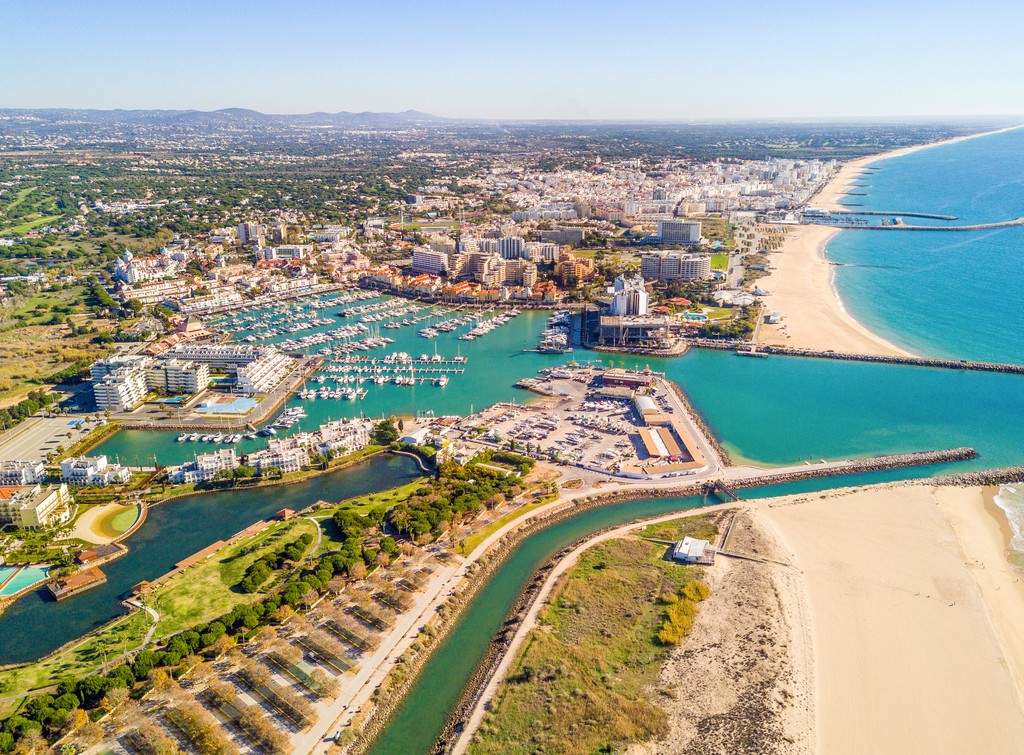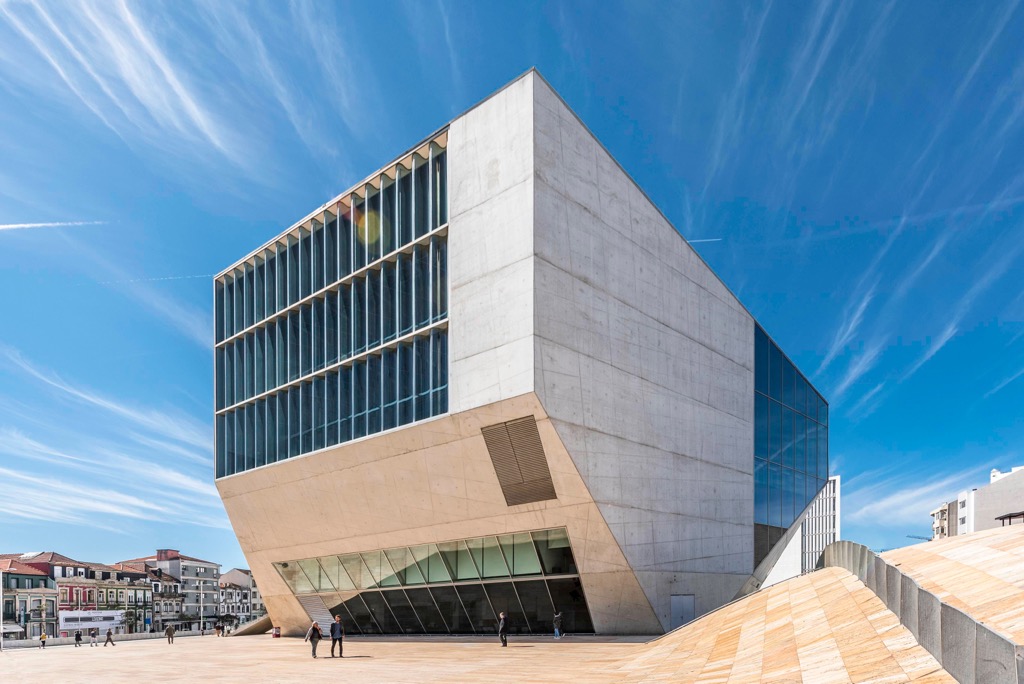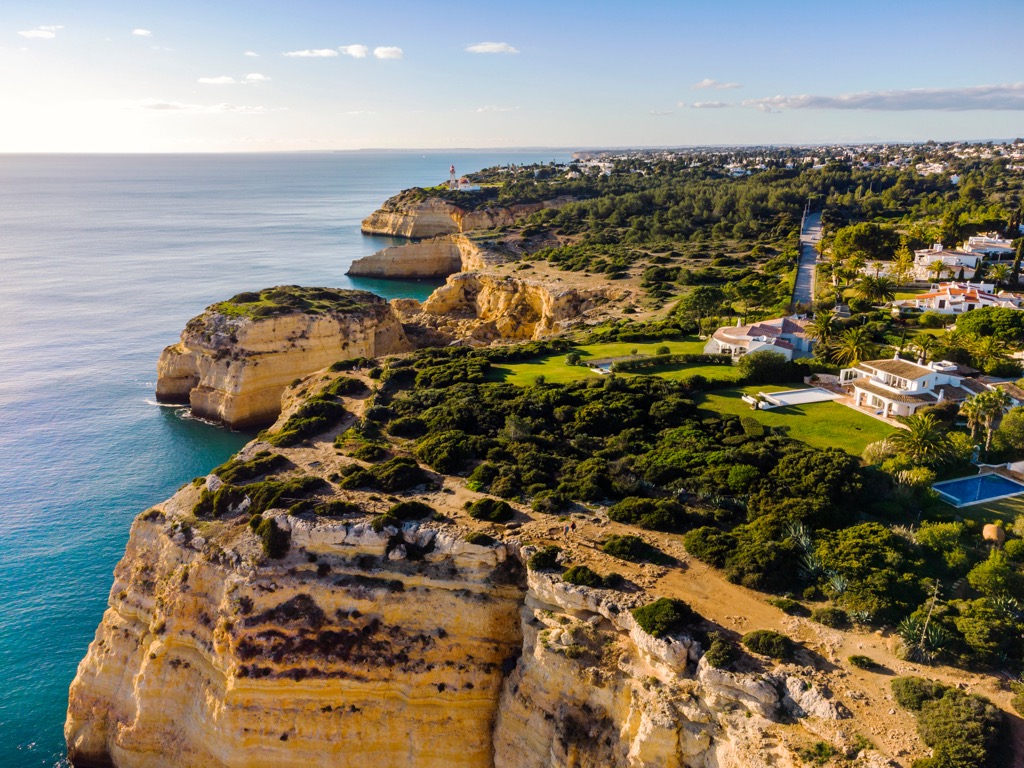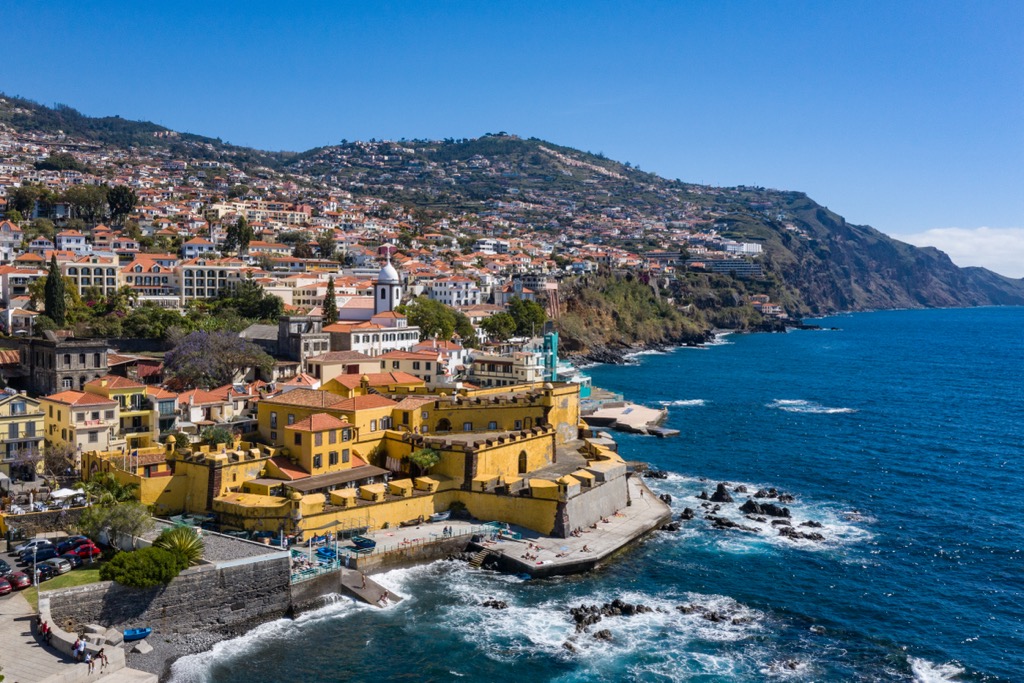Get PeakVisor App
Sign In
Search by GPS coordinates
- Latitude
- ° ' ''
- Longitude
- ° ' ''
- Units of Length
Share×

Scan the QR code and open PeakVisor on your phone
❤ Wishlist ×
Choose
Delete
Pristine sandy beaches, lush forested mountains, and some of Europe's oldest cities await hikers in Portugal. There are 3853 named mountains in Portugal. The highest and most prominent mountain is Montanha do Pico (2,351 m/ 7,713 ft).

Portugal, officially the Portuguese Republic (República Portuguesa), is a country located on the Iberian Peninsula in southwestern Europe. It covers an area of approximately 92,212 sq km (35,603 sq mi).

Portugal sits on the western edge of the Iberian Peninsula, with its coastline bordering the North Atlantic Ocean. Two island archipelagos are a part of Portugal: Madeira and the Azores. Spain is the only country that shares a border with Portugal.
The coastline of mainland Portugal is approximately 943 km (586 mi) in length and is characterized by world-class beaches and dramatic cliffs. The Algarve region on Portugal's southern coastline is especially famous for its alternating coastal features.

Topographically and climatically, Portugal is split in two by the Tagus River Delta. The Tagus flows from Spain near Cedillo across the width of Portugal to Lisbon. The landscape to the south of the Tagus consists of rolling hills and is warm and dry. To the north of the Tagus, the landscape is mountainous, with a temperate and rainy climate.
There are no natural lakes within continental Portugal. The biggest body of water is the Alqueva Reservoir (250 sq km/97 sq mi), which is the largest artificial lake in Western Europe. Aside from the Tagus, significant rivers in Portugal include the Douro, the Guadiana, and the Minho.

The Madeira archipelago is located approximately 800 km (497 mi) to the southwest of Portugal. It encompasses an area of roughly 800 sq km (308 sq mi) across four main islands. Madeira Island is by far the largest island in the archipelago, with an area of 740 sq km (285 sq mi).
The Azores archipelago is located approximately 1,400 km (870 mi) to the west of Lisbon. It covers an area of roughly 2,351 sq km (908 sq mi) across nine islands and islet groups, the largest of which is São Miguel, at 759 sq mi (293 sq mi). The Azores’ Pico Island is home to the highest mountain in Portugal, Montanha do Pico (2,351 m/ 7,713 ft).
Portugal is home to one national park, Peneda-Gerês National Park (Parque Nacional da Peneda-Gerês), which is located on the northern border with Spain.

Lisbon is the capital and largest city in Portugal. Other notable cities include Porto, Braga, Funchal, and Coimbra.
The Iberian Peninsula has a complex geological structure. It contains rocks from every geological period from the Ediacaran around 635 million years ago to the current Quaternary. The Iberian Peninsula's core is formed from a cratonic block from the Variscan Orogeny called the Iberian Massif.
Portugal is geologically related to the supercontinent Gondwana. Portugal began to form when the Pangea split into smaller pieces, and Gondwana began to align with the rest of Europe.

The Iberian Plate, which includes not only the Iberian Peninsula but also Corsica, Sardinia, and the Balearic Islands, was formed during the Cadomian Orogeny. The Cadomian Orogeny was a tectonic event during the Neoproterozoic Era roughly 650–550 million years ago.
The exact events of the Cadomian Orogeny are uncertain but are believed to have involved the collision of several island arcs which splintered from the margins of Gondwana.
These islands, which included the Central Iberian Plate, Ossa-Morena Plate, and South Portuguese Plate, never separated far from each other following this orogeny.

As Europe and Iberia began to drift away from North America, the Mid-Atlantic fracture zone pulled the continents in three different directions. Iberia eventually collided with southern France, forming the Iberian Peninsula. Since the Oligocene epoch between 33.9 million to 23 million years ago, the Iberian Peninsula has been moving as part of the Eurasian Plate.

Rock and mineral types across Portugal vary to the number of tectonic events and rock intrusions. The Central Iberian Zone, which includes parts of north and central Portugal, contains Precambrian gneisses, some of the oldest rocks in the country. Also in these areas are shales, schists, quartzites, and granites.
Precambrian rocks can also be found in the Ossa Morena Zone, which forms a band across southern Portugal. The South Portuguese Zone, which compasses much of the Algarve region, consists of rocks only from the Upper Devonian to Carboniferous periods. These rocks include Late Devonian phyllite and quartzite. Volcanic rocks in this zone contain manganese, zinc, and pyrite ores.
The highest mountains in mainland Portugal are located in the central and northern regions. The Serra da Estrela is the highest mountain range on the Portuguese mainland. The highest point in continental Portugal is Torre (1,993 m/6,637 feet), which is not a distinctive peak but rather the highest point in the range.

Other notable summits in mainland Portugal include Pico Ruivo (1,861 m/6,106 ft), Pico da Nevosa (1,548 m/5,079 ft), Pico do Arieiro (1,818 m/5,965 ft).
With a mixture of North African and European flora and fauna, Portugal is one of the world's most biodiverse countries. Portugal is home to 488 threatened plant and animal species, the second-highest number in Europe. Read on to learn about Portugal's wildlife.
Common mammals found within Portugal include Iberian hares, Iberian ibex, wild boars, foxes, and deer. The Iberian wolf is considered one of the national symbols of Portugal and can be found in the country's north.
Endangered mammal species that inhabit Portugal include garden dormice, Eurasian otters, and Pyrenean desmans. Conservation efforts are slowly returning Iberian lynx to the Iberian Peninsula, with over 480 individuals across Spain and Portugal.

While Portugal does not have an official national bird, it's widely regarded as the rooster. As one of Europe's most westerly countries, Portugal is an important stopover for many migratory birds, including white storks, Eurasian hoopoes, great spotted cuckoos, and lesser kestrels.
Notable reptile species found in Portugal include European pond turtles, viperine water snakes, Iberian wall lizards, and western three-toed skinks. Seoane's viper is the most common venomous snake in Portugal.
Many amphibian species inhabit the swamps and marshes of Portugal, such as Iberian painted frogs, fire salamanders, and marbled newts.
Insects are the most numerous animals in Portugal, with over 700 beetle species alone. Notable insect species include striped shield bugs, mammoth wasps, European mole crickets, and European mantises.

Many vibrant butterfly species can be seen across Portugal, especially in the Algarve region. Examples include peacock butterflies, red admirals, swallowtails, and monarchs.
Many fish species inhabit the Tagus and its tributaries, including trout and barbels. Portugal's artificial lakes are home to carp, pikes, and black bass.
Approximately 38 percent of Portugal is forested. Eucalyptus, cluster pines, and cork oaks make up roughly 71 percent of all forests in continental Portugal. Other common trees include holm oaks, Scots pines, and chestnuts.
There are over 3,600 plant species in Portugal. Many endemic and rare plant species, including several orchis, grow across Portugal. Some of Portugal's most common and unusual orchids include naked man orchids, bee orchids, and green-winged orchids.
Lavender is the national flower of Portugal and can be found growing across the central shrublands and grasslands. Yellow rockroses are also a common sight in these areas.

During spring and summer, Portugal is ablaze with vibrant wildflowers. Notable examples of wildflowers in Portugal include irises, rhododendrons, bluebells, daffodils, and thistles.
Fungi species are numerous in Portugal, with prominent examples including fly agaric, puffballs, and shaggy inkcaps.
Humans have been inhabiting Portugal since the Paleolithic Era, with Homo sapiens entering the Iberian Peninsula around 10,000 years ago. Many of the earliest human settlements in Portugal were hill villages built in northern Portugal by Neolithic farmers. Read on to learn more about Portugal’s human history.

The word Portugal originates from Portus Cale, a Celtic-Roman town in modern-day northern Portugal near Porto. Some historians believe Celts invaded Portugal during the first millennium BCE and intermarried with the local population.
Between the first century BCE and the third century CE, Portugal was a part of the Roman Republic within the dominions of Lusitania and Gallaecia. The conquest was bloody and took over 200 years due to the Punic Wars and rebellions by the Lusitanians.
By the fifth century CE, the Germanic Suebi tribe and its allies reached Portugal, forming the Kingdom of the Suebi. However, the Siebi would feud with the Visigoths over the next few hundred years.

By the eighth century, the Visigoths fully controlled the Iberian Peninsula. Despite this, the Suebi left a lasting cultural and genetic influence on Portugal, especially in the north.
From the eighth to the thirteenth century, Portugal was a part of the al-Andalus, a Muslim-controlled region of the Iberian Peninsula under the Umayyad Caliphate.
Areas of Portugal between the Minho and Douro Rivers were reconquered in the ninth century by Vímara Peres, the first Count of Portugal, near the start of the over 700-year Reconquista period.

Portugal became an independent country following the Battle of São Mamede in 1128. The battle was won by Afonso Henriques, the Count of Portugal, who became the first King of Portugal.
Portugal has been an independent nation since the twelfth century, making it one of Europe's oldest continuously independent countries. The Reconquista period lasted until the mid-fifteenth century, with Christians slowly regaining the Iberian Peninsula from the Moors.
During the Age of Discovery between the fifteenth and seventeenth centuries, Portugal established itself as the first global maritime empire, discovering Brazil in 1500.

Many Portuguese explorers were the first to travel to parts of the world previously unvisited by Europeans. In 1498, Vasco da Gama accomplished what Columbus couldn't by reaching India. Portuguese explorers also landed in parts of East Asia, including Timor, Japan, and Taiwan.
For 60 years, Portugal and Spain joined in union under King Philip II of Spain following the Portuguese succession crisis of 1580. The lack of independent foreign policy under the Spanish union led to Portugal's involvement in the Eighty Years' War.
Following the Dutch-Portuguese War and Portuguese Restoration War, the Iberian Union ended with the beginning of the reign of the House of Braganza, which lasted until 1910.
During the eighteenth century, as many as 600,000 Portuguese migrants left for Brazil, one of the largest mass migrations in European history. Brazil became independent from Portugal in 1825, following Portugal's slow economic decline during the Napoleonic Wars.
Between 1853 and 1861 during the short reign of King Pedro V, Portugal began to modernize, building infrastructure and improving public health services.
After losing many of its overseas colonies, Portugal began to formally colonize areas of Africa, setting up several colonies, including Mozambique, Angola, and Portuguese Guinea. Portugal also still controlled a few colonies in Asia.
In 1892 and again in 1902, Portugal was declared bankrupt. These financial issues led to societal unrest and the rise of republican sentiment, culminating in the assassination of King Dom Carlos I of Portugal and his heir in 1908.

King Carlos I's second son, Manuel II of Portugal, became king but was overthrown in 1910, resulting in the establishment of the Portuguese Republic.
The First Portuguese Republic suffered economic issues, which were compounded by the First World War. Following the political upheaval of the failed 28 May 1926 coup d'état, the right-wing Estado Novo dictatorship was established.
Portugal was neutral in the Second World War but helped found NATO and the European Free Trade Association (EFTA) in the aftermath.
Independence movements of African colonies led to the Portuguese Colonial War between 1961 and 1974. Despite heavy pressure from the international community, the Estado Novo tried to preserve its colonial empire.
In April 1974, the Carnation Revolution, led by left-wing military officers, led to a coup and the return of democracy. The aftermath led to the independence of overseas territories in Africa and Asia.
In 1975, Portugal was on the verge of a civil war and narrowly avoided being established as a communist state. Portuguese Angola and Mozambique gained independence in 1975.
Two years after the Carnation Revolution, the Portuguese Socialist Party (PS) won the 1976 election, leading to Portugal's integration into modern Europe.

In 1986, Portugal and Spain joined the European Economic Community (EEC), which would later become the EU. Portugal peacefully handed over its last colony, Macau, to China in 1999. In 2009, following the Treaty of Lisbon, Portugal became an official part of the EU.
From the Azores' active volcanoes to the Algarve's rugged sea cliffs, Portugal is the perfect destination for your next hiking adventure.
Portugal is underrated for hiking, meaning some of its best hikes are in remote areas. Before setting out, ensure you come well-prepared with appropriate hiking gear, enough food and water, and a GPS. Inform others of your itinerary and check local weather forecasts.
Read on to learn about some of the best hikes in Portugal.

Montanha do Pico (2,351 m/ 7,713 ft), or Mount Pico, is a dormant stratovolcano located on Pico Island in the Azores. It's the highest mountain in Portugal. The Azores are known for their natural beauty, and the summit of Montanha do Pico affords spectacular views across Pico Island to the Atlantic Ocean.
The best way to reach the crater atop Montanha do Pico is from the Casa da Montanha (1,233 m/4,045 ft) on the volcano's western slope. The Mountain House is located halfway up the mountain, so you'll only have to climb another 1,100 m (3,809 ft) to reach the summit.
The hike up Montanha do Pico is very steep and potentially dangerous. It's worth hiring a local guide if you're inexperienced, as they can show you the best route and shortcuts. There is an entrance fee to climb Montanha do Pico.

There is no fixed trail to reach the summit of Montanha do Pico — instead, there are 47 numbered poles that lead to the top. By number 44, you'll have reached the summit crater.
To reach the highest point in Portugal, you'll need to climb Piquinho, a minor summit atop Montanha do Pico. It's the hardest part of the trek, with a 15-minute scramble to reach the peak of Piquinho. The hike to the top of Montanha do Pico is a 7 or 8-hour round trip.
The 444 sq km (171 sq mi) Madeira Natural Park (Parque Natural da Madeira) encompasses the central portion of Madeira Island. It protects Madeira's heavily wooded mountains, fragile ecosystem, and endemic flora and fauna.
Pico Ruivo (1,861 m/6,106 ft) is the highest mountain in Madeira Natural Park and the sixth-highest mountain in Portugal. The strenuous walk to the summit, combined with the panoramic views of nearby summits, makes Pico Ruivo one of Portugal's most exciting hiking destinations.

The best way to reach the summit of Pico Ruivo is along the PR1 trail from the summit of Pico do Arieiro (1,818 m/5,965 ft), Madeira's third-highest mountain. It's possible to park your car at the summit of Pico do Arieiro. From Pico do Arieiro, it's possible to see the island of Porto Santo, which is located 48 km (30 mi) to the south.
The PR1 is among the most popular trails in Portugal, with over 1,000 visitors daily. The trail starts by visiting the Ninho da Manta belvedere, where it's possible to see Zino's petrel, a seabird that's endemic to Madeira.
The trail then climbs a series of steep rocky steps around Pico das Torres (1,853 m/6,079 ft), Madeira's second-highest mountain. The trail then descends before climbing to the summit shelter Pico Ruivo.
The PR1 is a well-developed trail but is quite strenuous. The PR1 is approximately a 13 km (8 mi) round trip.
Other popular mountains in Madeira Natural Park include Pico Grande (1,654 m/5,427 ft), Pico do Juncal (1,801 m/5,909 ft), and Pico do Jorge (1,691 m/5,548 ft).

Serra da Estrela is the highest mountain range in continental Portugal. It's located in Central Portugal, approximately 100 km (62 mi) to the east of Coimbra.
The range is the primary feature of the 1,010 sq km (390 sq mi) Serra da Estrela Natural Park (Parque Natural da Serra da Estrela), the largest protected landscape in Portugal.
Serra da Estrela is popular with tourists due partly to the Ski Resort of Serra da Estrela (Estância de Ski da Serra da Estrela), which is considered the best ski resort in Portugal.
This mountain range is home to Torre (1,993 m/6,637 ft), the highest point in Mainland Portugal and the second highest point in the Portuguese Republic after Montanha do Pico (2,351 m/ 7,713 ft) in the Azores. Torre is not technically a mountain summit but the highest point on a plateau in the Serra da Estrela range.

One of the best ways to climb Torre is from Alvoco da Serra to the southwest. This out-and-back route begins by following the Alvoco River before climbing steeply uphill.
The hike is considered difficult, but the panoramas from the top of Torre are worth it, with views stretching for 100 km (62 mi) on clear days. It's also possible to drive to the top of Torre.
Other popular mountains in Serra da Estrela Natural Park include Cântaro Magro (1,928 m/6,325 ft), Cântaro Raso (1,916 m/6,286 ft), and Poios Brancos (1,704 m/5,591 ft).
Peneda-Gerês National Park (Parque Nacional da Peneda-Gerês) is Portugal's only national park. It rests on Portugal's northern border with Spain and is the oldest protected area in the country.
Peneda-Gerês National Park centers around two granite massifs: Serra da Peneda and the Serra do Gerês. With its sweeping valleys, verdant mixed-leaved forests, and rare wildlife, Peneda-Gerês National Park is very popular with hikers.

Follow the GR50 if you're looking to explore Peneda-Gerês National Park extensively. This 190 km (118 mi) long-distance trail leads from Ameijoeira on the Portugal-Spain border through the best of the park to Tourém.
Along the way, you'll get to enjoy some incredible views of beautiful landscapes like the Gerês Valley and the Conho Valley.
One of the best day hikes in Peneda-Gerês National Park is the Pedra Bela trail. This looped trail starts from Vilar da Veiga and leads to the Pedra Bela viewpoint (Miradouro da Pedra Bela) on Pedra Bela (834 m/2,736 ft), which affords stunning views towards the Cávado River. The Pedra Bela trail is approximately 13.2 km (8.2 mi) in length.
Popular mountains in Peneda-Gerês National Park include Pico da Nevosa (1,548 m/5,079 ft), Pedrada (1,417 m/4,649 ft), and Xertelo (893 m/2,930 ft).
The Algarve is a region that encompasses the southern coastline of Portugal. It's arguably mainland Portugal's most important tourist area, with its pristine beaches, dramatic limestone cliffs, and picturesque fishing villages.
There's no better place in continental Portugal for a coastal hike than the Algarve. It's home to one of the finest coastal walks in Europe, the Seven Hanging Valleys Trail. The 5.7 km (3.5 mi) trail leads from Praia da Marinha to Praia de Vale Centianes.

It winds along the Algarve's coastal cliffs, passing significant cultural and natural landmarks, like the Alfanzina Lighthouse (Farol de Alfanzina) and the Benagil and Carvalho beaches. The Praia da Marinha is widely thought of as one of the finest beaches in Europe.
If you're feeling particularly adventurous, rent a kayak or boat and explore Benagil Cave (Grotte de Benagil). This famous cave is only accessible by sea and features a large domed roof with a hole at the top, known as "the eye." Benagil Cave ranks as one of Portugal's most famous natural landmarks and shouldn't be missed.
One of the oldest countries in Europe, Portugal is home to cities brimming with ancient attractions and cultural delights. Read on to learn about some of the main cities in Portugal.
Lisbon (Lisboa) is the capital and largest city in Portugal. The second-oldest capital city in Europe after Athens, Lisbon is home to numerous historical landmarks, like the sixteenth-century Belém Tower (Torre de Belém) and the twelfth-century Saint George's Castle (Castelo de São Jorge).

Lisbon is a favorite destination for sunseekers, with roughly 290 days of sunshine annually. And there's no shortage of places to soak up the sun, with many high-class seafront restaurants and sandy beaches like Praia da Mata. Whether you're spending your downtime shopping, touring museums, or discovering Portuguese culture, Lisbon doesn't disappoint.
Popular hotels in Lisbon include VIP Grand Lisboa Hotel, Tivoli Oriente Hotel, and Hotel Mundial.
Located approximately 300 km (186 mi) up the coast from Lisbon is Portugal's second city, Porto. Porto is famous for port wine, its UNESCO-protected city center, and its beautiful riverside promenade. Porto is known as the City of the Bridges (Cidade das Pontes) due to the six bridges that span the Douro River.

Whether you're looking to take a Douro Valley wine tour or admire the architecture of the Romanesque Porto Cathedral (Sé do Porto), Porto offers something for everyone. Porto is regularly voted as one of the best travel destinations in Europe.
Popular hotels in Porto include Hotel Carris Porto Ribeira, Pao de Acucar Hotel, and Vincci Porto.

Braga is the most northerly major city in Portugal. It's the perfect base from which to explore Peneda-Gerês National Park, which is located just 36 km (22 mi) to the northwest. Braga is a Portuguese city worth visiting, with its vibrant nightlife, stunning architecture, and historical landmarks.
Braga is home to the twelfth-century Braga Cathedral (Sé de Braga), the oldest cathedral in Portugal and one of the country's most important buildings. Other architectural wonders worth seeing in Braga include the Arch of the New Gate (Arco da Porta Nova) and Sameiro Sanctuary (Santuário do Sameiro).

Popular hotels in Braga include Melia Braga Hotel, Vila Gale Collection Braga, and Basic Braga by Axis.
Funchal is the largest and capital city of Madeira. Located on Madeira Island's southern coastline, Funchal affords easy access to many of Madeira's best hiking areas. Madeira Natural Park (Parque Natural da Madeira), which contains Pico Ruivo (1,861 m/6,106 ft), is less than 30 km (18.6 mi) from Funchal.
Funchal is the ideal destination for nature lovers, with several lush botanical gardens, including the unmissable Monte Palace. Funchal is also home to an eclectic mix of museums, from the Christiano Ronaldo CR7 Museum (Museu CR7) to the Sacred Art Museum of Funchal (Museu de Arte Sacra do Funchal).

Popular hotels in Funchal include Pestana Carlton Madeira, Turim Santa Maria Hotel, and Dorisol Estrelicia Hotel.
Perched on the winding Mondego River, Coimbra is the fourth-largest city in continental Portugal. Coimbra is an ancient city dating back to the Roman Era when it was called Aeminium. Many Roman structures in Coimbra are well-preserved, including the Ruins of Conímbriga (Ruínas de Conímbriga), one of the largest Roman ruins in Portugal.
Today, Coimbra is a university city that isn't overrun with tourists, making it perfect for hikers who'd prefer a quiet getaway. Coimbra is located less than 120 km (74.5 mi) from Serra da Estrela Natural Park (Parque Natural da Serra da Estrela), making the park easy to reach on a day trip.
Popular hotels in Coimbra include Vila Gale Coimbra, Hotel Oslo, and Tivoli Coimbra.

Explore Portugal with the PeakVisor 3D Map and identify its summits.








